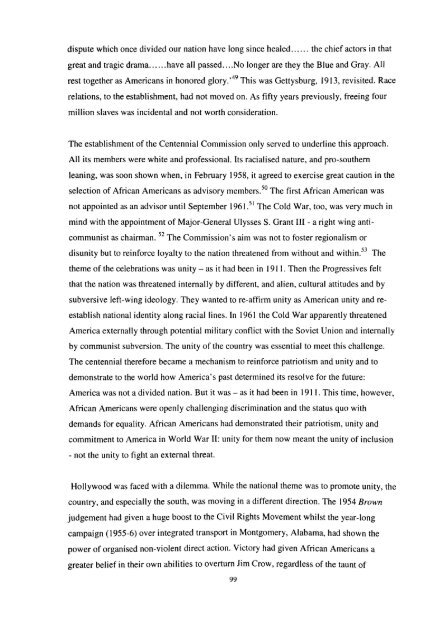Download (3483kB) - Greenwich Academic Literature Archive ...
Download (3483kB) - Greenwich Academic Literature Archive ...
Download (3483kB) - Greenwich Academic Literature Archive ...
- No tags were found...
Create successful ePaper yourself
Turn your PDF publications into a flip-book with our unique Google optimized e-Paper software.
dispute which once divided our nation have long since healed...... the chief actors in thatgreat and tragic drama......have all passed....No longer are they the Blue and Gray. Allrest together as Americans in honored glory.' 49 This was Gettysburg, 1913, revisited. Racerelations, to the establishment, had not moved on. As fifty years previously, freeing fourmillion slaves was incidental and not worth consideration.The establishment of the Centennial Commission only served to underline this approach.All its members were white and professional. Its racialised nature, and pro-southernleaning, was soon shown when, in February 1958, it agreed to exercise great caution in theselection of African Americans as advisory members. 50 The first African American wasnot appointed as an advisor until September 1961. 51 The Cold War, too, was very much inmind with the appointment of Major-General Ulysses S. Grant III - a right wing anti-communist as chairman. 52 The Commission's aim was not to foster regionalism ordisunity but to reinforce loyalty to the nation threatened from without and within. 53 Thetheme of the celebrations was unity - as it had been in 1911. Then the Progressives feltthat the nation was threatened internally by different, and alien, cultural attitudes and bysubversive left-wing ideology. They wanted to re-affirm unity as American unity and re-establish national identity along racial lines. In 1961 the Cold War apparently threatenedAmerica externally through potential military conflict with the Soviet Union and internallyby communist subversion. The unity of the country was essential to meet this challenge.The centennial therefore became a mechanism to reinforce patriotism and unity and todemonstrate to the world how America's past determined its resolve for the future:America was not a divided nation. But it was - as it had been in 1911. This time, however,African Americans were openly challenging discrimination and the status quo withdemands for equality. African Americans had demonstrated their patriotism, unity andcommitment to America in World War II: unity for them now meant the unity of inclusion- not the unity to fight an external threat.Hollywood was faced with a dilemma. While the national theme was to promote unity, thecountry, and especially the south, was moving in a different direction. The 1954 Brownjudgement had given a huge boost to the Civil Rights Movement whilst the year-longcampaign (1955-6) over integrated transport in Montgomery, Alabama, had shown thepower of organised non-violent direct action. Victory had given African Americans agreater belief in their own abilities to overturn Jim Crow, regardless of the taunt of99
















